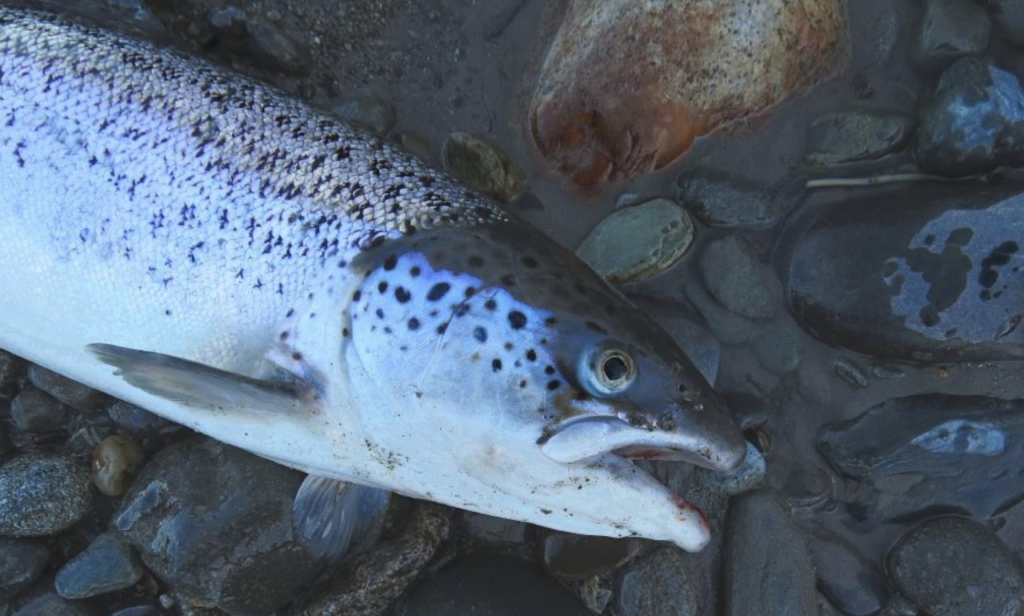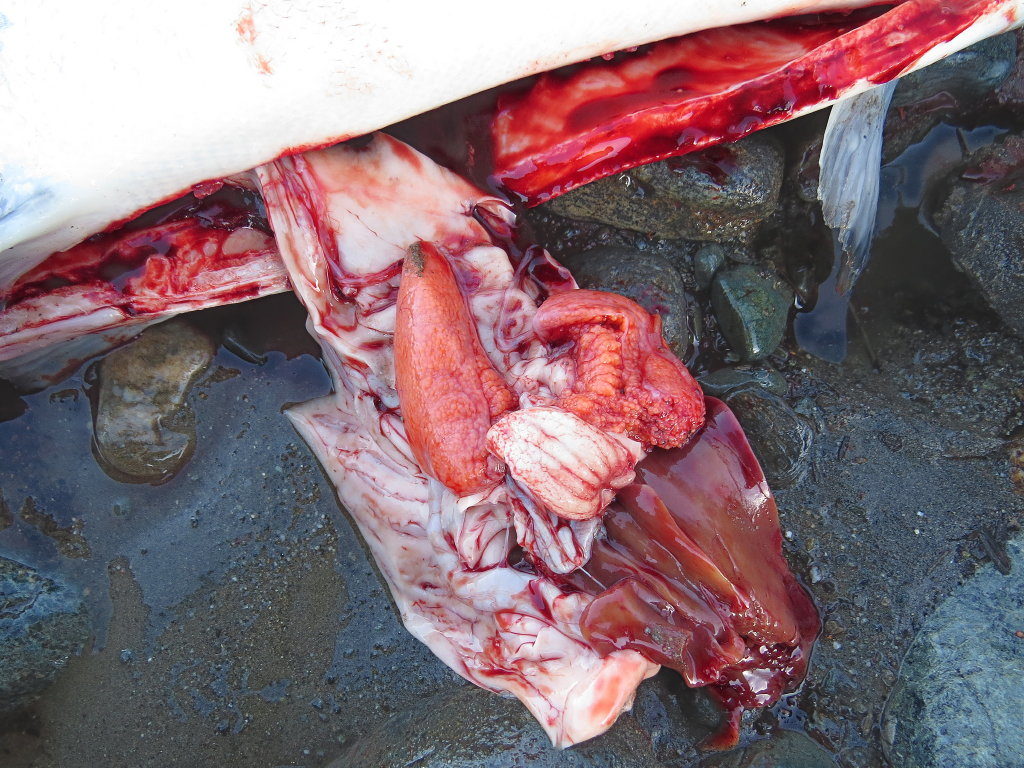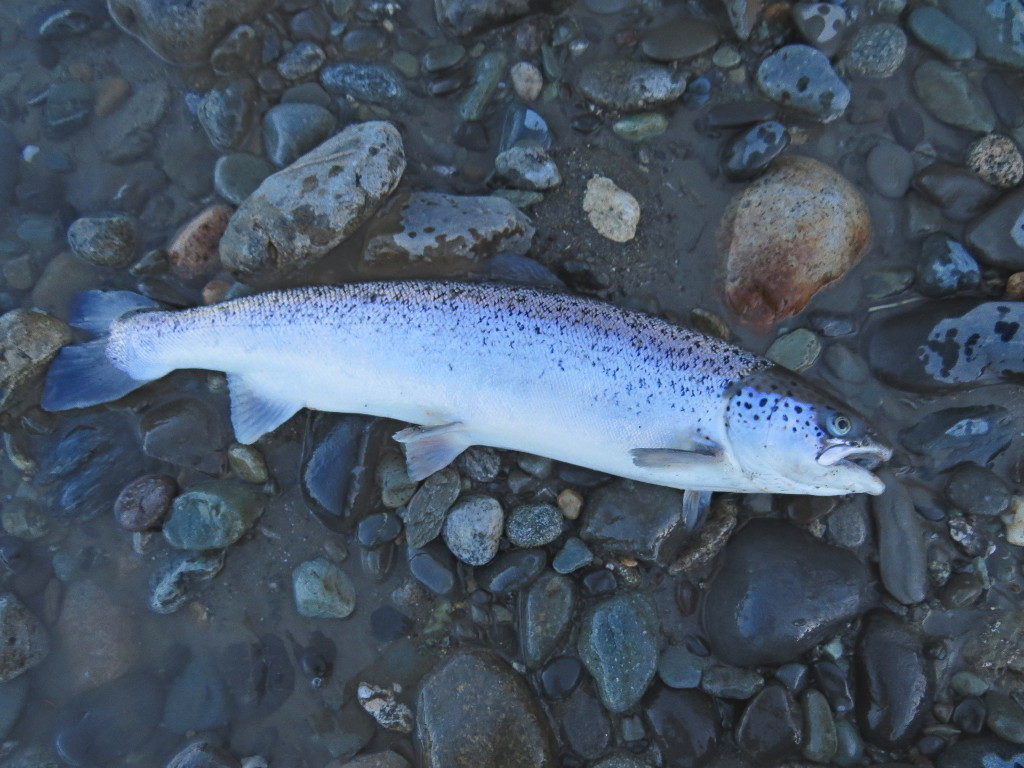
There are few people who know more about wild steelhead and salmon than Bill McMillan. He is a legend in the Pacific Northwest both for his steelhead science and angling tactics, so we’re honored to share his thoughts on the massive Atlantic salmon net pen disaster in Puget Sound. Months after this disaster, these escaped farmed fish are now being found in rivers that are critical wild fish habitat, and Bill weighs in with this piece about the threat these escaped fish pose to wild steelhead and salmon.
By Bill McMillan:
Though it’s not news that the escaped Atlantic salmon from the Cypress Island net pen failure have returned in large numbers to the Skagit River to at least Hamilton (RM 40-42 area), evidence is mounting about their continuing upstream Skagit migration. The collapsed net pen at Cypress Island is the only known recent source for Atlantic salmon escapees in the Salish Sea. They initially numbered over 300,000, with over 100,000 still unaccounted for after efforts –mostly by tribal fishermen, but also by sport fishermen–to contain them. The Cypress Island net pen was 15-25 miles from entry to the Skagit River depending on the route taken. Atlantic salmon have recently been caught as far as northwest Vancouver Island that were likely escapees from the Cypress Island incident 250 miles away. Reported catches have occurred throughout Puget Sound, including the Elwha River and areas even farther west along the Strait of Juan de Fuca.

This photo is of an Atlantic salmon caught at the end of December at about RM 46, about 5-6 miles upstream from the prior reports at the Hamilton location. It was a 29.5” female with eggs skeins that have matured considerably from where they were when I examined more than 60 carcasses back in August. Although there was no food in the stomach, that is not abnormal. These fish have extensive fat buildup from their confined net pen diet, even greater than those typically found in summer steelhead when they have been examined – or any other fish examined. This means they can live for the better part of a year in freshwater without feeding, and survive just as Skamania summer steelhead used to at the hatchery when I lived on the Washougal River. In a lifetime of fishing for steelhead and examining the stomach contents of adults that have been killed, it is rare to find food in their stomachs. A best guess would be 5% or less show feeding evidence as gut contents in summer runs and 1-2% in winter runs.
There have been erroneous claims by federal and state fishery managers that because these Atlantic salmon were fed pellets in net pens, there is little likelihood that they can feed themselves. Although many of these salmon may not learn to feed themselves prior to mortality, we know hatchery salmon and steelhead that have been reared on pellets prior to smolt release have high enough survival to return in significant numbers by learning to feed themselves. We don’t know whether any of the Atlantic salmon from the net pen spill will successfully procreate when they come to full maturation next fall, but there is reason to believe that some of them can survive that long and could spawn or otherwise interact with native salmon and steelhead. The Skagit Basin is one of the most likely places where this could happen.
Even if these Atlantic salmon do not live to spawn, they have already lived long enough to distribute around 50 miles from Skagit Bay up the Skagit River. If disease is present, it will have been carried that far in cohabitation with pink, chum, coho, and Chinook salmon since the August net pen spill, as well as steelhead, sea-run cutthroat, and bull trout.

There have been claims by federal and state managers that there is no known successful reproduction of Atlantic salmon on the West Coast. This is also incorrect – or at least incorrect in the assumption that there has been no spawning success. In a 2000 publication, it was found that the Tsitika River of northern Vancouver Island had juvenile Atlantic salmon present from probable spawning success by net pen Atlantic salmon escapees, and in 2014 another paper was published indicating that of 41 streams in BC that were snorkel surveyed in the search for juvenile Atlantic salmon, such juveniles were found in 36-37% of those streams.
I asked a friend who fishes off the Pressentin Ck area to let me know if he encounters any Atlantic salmon. He has yet to catch one, but he spoke with a fly fisherman who told him he had caught three of the Atlantic salmon since the Skagit opened to fishing (Dec. 16th) and had lost several others. They had been caught somewhere downstream from the Pressentin location (he did not reveal exactly where). This indicates that despite the Upper Skagit tribal netting of significant numbers of these fish, many were not caught by the netting and continue to survive and migrate within the Skagit Basin. To date, I have heard of no winter steelhead caught.
This tragic case reinforces the need to ban net pens immediately. Anglers also need to do everything they can to help contain the disaster. Please follow this link for info from The Conservation Angler on what to do if you catch an escaped Atlantic salmon.
Bill McMillan is the Archivist for The Conservation Angler. Bill helped found the Wild Fish Conservancy in 1989 and served as its Board Chair for ten years. Prior to that he explored rivers throughout Oregon and Washington, pioneering snorkeling investigations where his observations and findings supported his exhaustive historical research efforts into the region’s salmon and steelhead legacy.






I’ve caught quite a few winter steelhead
The problem with the Atlantic salmon escape in the Pacific North West, is that it is undetermined and unknown. We do not know the extent of the escape. It has been said in many articles that the salmon have been found to not eat the same things as the native species of anadromous fish in the area. According to this finding it does show that the Atlantic Salmon from the farm was found with food in its stomach. This causes a problem for the native Salmon to fight over food now. Not only is the native salmon a cultural keystone species, but an ecological keystone species as well. This escape could lead to interbreeding of the Atlantic and native salmon in the area. This causes a problem to native tribes who count on the cultural impact of the native salmon. There are plenty of animals that consume these fish, but as a farm raised we do not know if they carry and illnesses like sea louse. One of the amazing this to come from this is how the native tribes have come into the waterscape to find that escaped fish before the problem get worse. Hopefully all the escaped fish can be found and the extent of the problem can be limited.